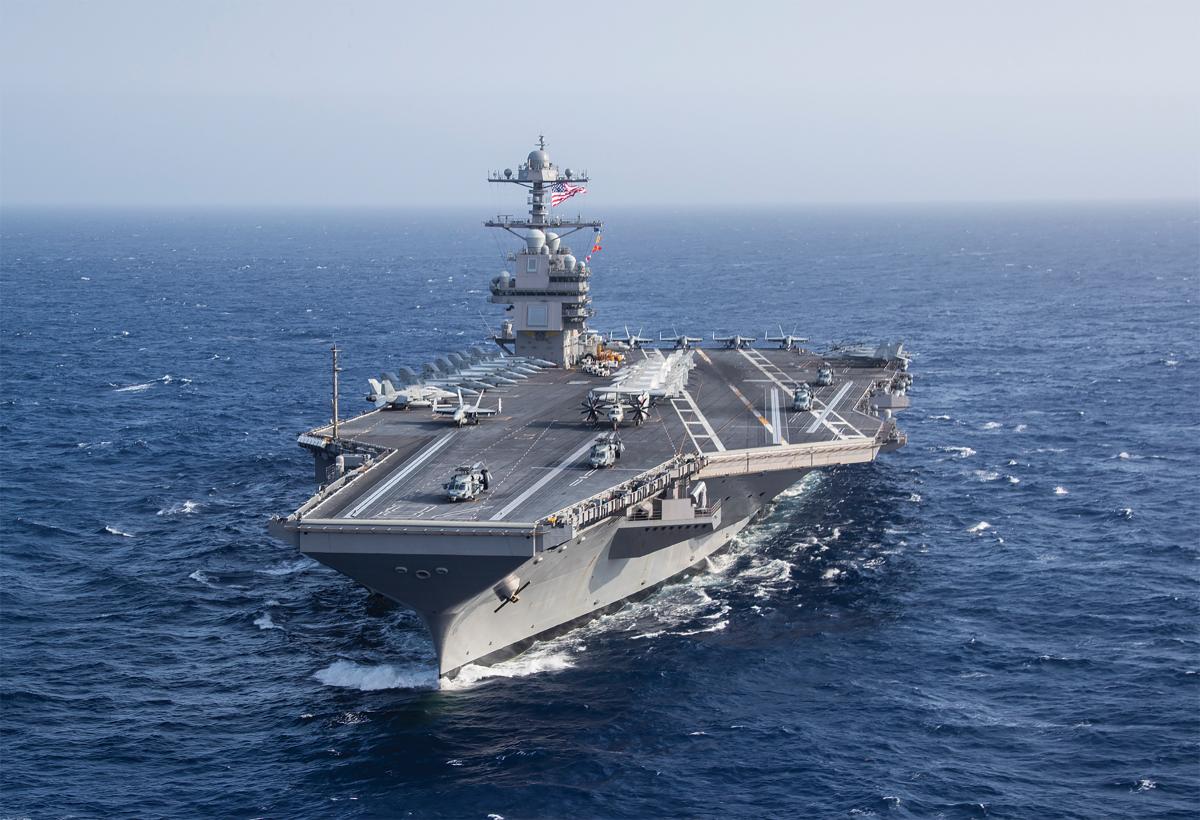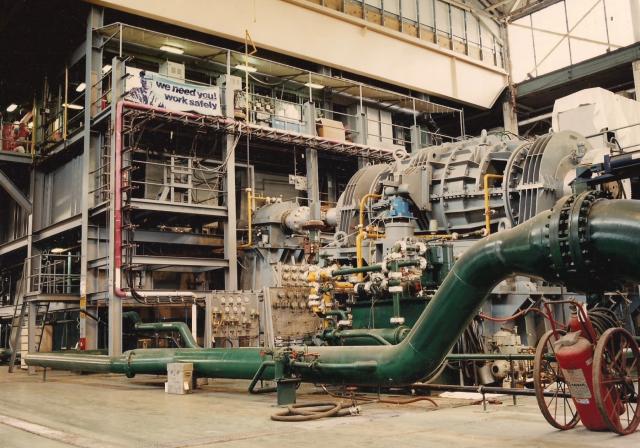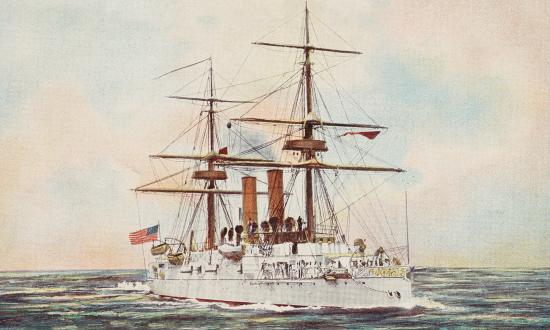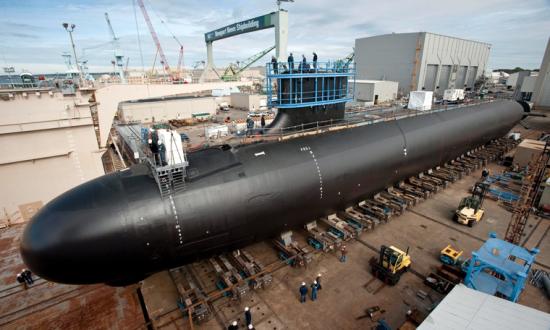As leaders in the Pentagon, Capitol Hill, and industry come to grips with great power competition with China and Russia, we all agree: We must accelerate innovative research and development, acquire new capabilities faster, and transform the way the U.S. military fights if it is to prevail. This is hardly the first time U.S. national security leaders have felt a sense of urgency and attempted to do so.
Unfortunately, results have been mixed at best, with absurd acquisition debacles that have set back the country tens of billions of dollars and delayed necessary weapon systems for years. While examples abound in each military service, we are particularly concerned with Navy shipbuilding. We believe there is a better way to develop new first-of-class ships.
As the Government Accountability Office (GAO) has documented, lead ships in new classes of naval vessels routinely fail to meet expectations. For the eight most recently delivered lead combatant ships—the USS Gerald R. Ford (CVN-78), Zumwalt (DDG-1000), Freedom (LCS-1), Independence (LCS-2), America (LHA-6), San Antonio (LPD-17), Virginia (SSN-774), and Texas (SSN-775)—the GAO found that a total of $8 billion more than the initial cost estimate was required to construct these ships, each lead ship experienced cost growth of at least 10 percent, and three exceeded their initial budgets by 80 percent or more. Further, each lead ship was delivered to the fleet at least six months late—five were more than two years late—and most had dozens of uncorrected deficiencies when the Navy accepted them.
GAO experts have continually noted a crucial step in successful shipbuilding programs is technology development—the maturation of key technologies into subsystem prototypes and demonstration of those prototypes in a realistic environment prior to the detailed design of the lead ship. This type of technology maturation was not performed effectively, if at all, on the CVN-78, DDG-1000, LCS-1, LCS-2, and LPD-17 programs.
It was not always this way. During the 1960s and 1970s, the Navy took a methodical, knowledge-based, subsystem-focused approach to developing the Aegis Combat System and SPY-1 radar. Rear Admiral Wayne E. Meyer, known as the “Father of Aegis,” led these programs by focusing on maturing subsystems based on his philosophy of “Build a Little, Test a Little, Learn a Lot.” The Aegis Combat System and SPY radar have been incrementally upgraded ever since, and continue to serve as the backbone of the Navy and multiple allied surface combatant fleets.
Achieving the aims of the 2018 National Defense Strategy is a long game; like China and Russia we must take the long view. With a number of new ship classes on the horizon, now is the time to return to the methodical, knowledge-based, subsystem-focused approach that worked in the past for fielding first-of-class ships. Defense leaders have called for developing and procuring the first Large Surface Combatant, Large Unmanned Surface Vehicle, Future Small Auxiliary, Future Large Auxiliary, and Light Amphibious Warship in the coming years. In addition, large and extra-large unmanned undersea vehicles will transition from research and development to procurement in the next decade.
This is a critical juncture and opportunity to do better on lead ships. To this end, we call for—and are encouraging with this year’s National Defense Authorization Act—the return to an Aegis-type development model in which critical subsystems are matured before the Navy procures the lead ship of a new class. This development should be based on a detailed understanding of the systems engineering necessary to mature the subsystems and the technical integration needed to achieve overall platform performance. Without such an approach, we are convinced the cost overruns, schedule delays, and substandard performance that have defined Navy lead-ship development over the past two decades will continue. It does not have to be this way.
We believe four principles should guide lead-ship development:
1. Department of Defense (DoD) and Navy leaders should lead on defining the future force architecture and, just as important, personally sign off on realistic system- and subsystem-level plans. Concept development and wargaming too often ignore the technical difficulty of new capabilities and platforms, including ships. Future force planning must involve requirements and acquisition strategies that are constrained by conditions-based technical development roadmaps for developing new critical subsystems and for modifying existing ones. If a subsystem is essential to the mission or to mechanical or electrical performance of a platform, we consider it critical.
2. New critical subsystems should be proven before building a full-scale platform. If a critical subsystem has not been demonstrated in the envisioned form, fit, and function, it needs to be prototyped (on land or at sea) as a subsystem and proven to meet minimum requirements. Then, it needs to be prototyped with the critical subsystems with which it will interface to ensure sufficient technological maturity of the system of systems.
This type of process has worked in the past and works today. Some recent examples of successful government- and contractor-led critical subsystem prototypes that provide significant benefits to both the government and industry include: the land-based engineering site for key electrical and propulsion subsystems (including control software) for surface combatants at Naval Surface Warfare Center Philadelphia; the land-based engineering site for the Aegis Weapon System at a contractor facility; and, prior to the 2016 decision to integrate the radar on DDG-125, the full-scale prototype testing of the SPY-6 Air and Missile Defense Radar at a contractor facility.
3. Contracting for a full-scale platform prototype should occur only after all critical subsystems have been proven and should focus on system integration. Having prototyped critical subsystems and demonstrated they are fully developed and technically sound, the Navy can base full-scale platform prototypes on subsystem integration, rather than on technology development. As platform integration issues arise, having subsystem prototyping already completed should enable faster root-cause analyses and corrective actions.
If a critical subsystem cannot meet minimum requirements, the Navy should not proceed to prototyping a full-scale platform. The focus should be kept on proving all critical subsystems first. For example, until the vessel-representative engine and generator (including ancillary equipment) have run continuously for 30 days on a test stand, the Navy should not contract for a large unmanned surface vehicle full-scale prototype, the minimum requirement for which is operating unattended for 30 days. Without an engine that meets the minimum specifications, the ship cannot meet the minimum requirements.
4. The objective of subsystem and full-scale platform prototyping is to close the government’s technical knowledge gaps. Some observers believe government involvement in technology development slows innovation. On the contrary, the government technical community is key to speeding the government’s adoption of innovative capabilities and, just as critical, sustaining these systems once fielded.
In areas where government expertise strains to keep up with industry advances, leaders must ensure government technical experts receive adequate resources to keep pace. The standard must be for DoD to maintain a cadre of technical experts as knowledgeable as any outside expert in the application of a given technology to a DoD weapon system, particularly critical subsystems. The technical support community for Navy submarines exemplifies this standard of expertise.
We recognize Congress has an important role to play—indeed, a constitutional duty—in maintaining our Navy. To this end, the National Defense Authorization Act (NDAA) for Fiscal Year 2020 contained provisions that would support this alternative approach, including:
- Section 131, which required the results of test programs of subsystem prototypes, as well as design changes identified during the operational test periods of the first Arleigh Burke–class destroyer in the Flight III configuration, be incorporated prior to program initiation of the next new class of Navy large surface combatants,
- Section 1034, which established a Senior Technical Authority (STA) for each class of naval vessels. Each STA is responsible for establishing, monitoring, and approving technical standards, tools, and processes for the class of naval vessels. The STA must certify the systems engineering and subsystem prototyping plans prior to program initiation of a lead ship in a new class.
In the Senate Armed Services Committee NDAA for Fiscal Year 2021, which the Senate approved 86–14 in July, we furthered this approach by including:
- Section 122, which requires the qualification of main engines and electrical generators capable of meeting requirements prior to program initiation for medium and large unmanned surface vessels,
- Section 237, which requires a certification from the Under Secretary of Defense for Research and Engineering on subsystem prototyping and maturity prior to the DoD’s contracting for certain unmanned vessels.
We believe the case is clear and compelling that successful prototyping of individual critical subsystems is essential to achieving a solid technical foundation for new platforms, particularly in shipbuilding. Rather than delaying new programs, this approach will enable the delivery of capable, reliable, and sustainable platforms that meet the needs of military commanders faster than would otherwise occur.
Leaders in the Pentagon, Capitol Hill, and industry must recognize that speeding innovative research and development, acquiring new capabilities faster, and transforming the way the U.S. military fights will require the disciplined demonstration of critical subsystems first. We look forward to working together toward this end. The stakes are real, and we have no time to waste.







